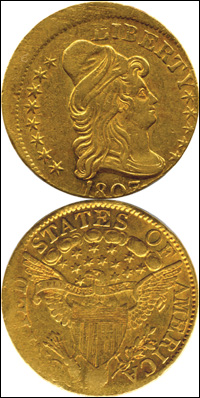

 It is very rare for any U. S. gold coin to be also a mint error. In fact, among the earliest styles of U. S. gold coins (1795-1807), I am unaware of a single truly off-center piece.
It is very rare for any U. S. gold coin to be also a mint error. In fact, among the earliest styles of U. S. gold coins (1795-1807), I am unaware of a single truly off-center piece.
 So why doesn’t this early gold coin with a 10% off-center obverse qualify as an off center piece? The reason is that the reverse is not struck off-center, making this coin instead a type of error known as a misaligned die error.
So why doesn’t this early gold coin with a 10% off-center obverse qualify as an off center piece? The reason is that the reverse is not struck off-center, making this coin instead a type of error known as a misaligned die error.
 With a misaligned die error, the dies that strike the coin don’t come together perfectly. The upper die is not centered above the lower die. Therefore the die faces, where the details of the coin are located, meet in an off center position relative to each other.
With a misaligned die error, the dies that strike the coin don’t come together perfectly. The upper die is not centered above the lower die. Therefore the die faces, where the details of the coin are located, meet in an off center position relative to each other.
 In the case of this coin, the result is an obverse that is off center about 10% at 4:30 o’clock, leaving a blank area at 10:30. Because the obverse die did not strike the blank area, the reverse of the coin that is directly behind the blank area will not be subject to much striking force, and will be weakly struck at best. Sure enough, the reverse of this coin is missing detail at 7:30 o’clock, exactly behind the blank area of the obverse.
In the case of this coin, the result is an obverse that is off center about 10% at 4:30 o’clock, leaving a blank area at 10:30. Because the obverse die did not strike the blank area, the reverse of the coin that is directly behind the blank area will not be subject to much striking force, and will be weakly struck at best. Sure enough, the reverse of this coin is missing detail at 7:30 o’clock, exactly behind the blank area of the obverse.
 What probably happened was that when this coin was being struck it was positioned perfectly on the reverse (anvil) die; the obverse (hammer) die then hit it about 10 % off-center.
What probably happened was that when this coin was being struck it was positioned perfectly on the reverse (anvil) die; the obverse (hammer) die then hit it about 10 % off-center.
 We know that there was quite good quality control for early U. S. gold coins. So how did they miss this one?
We know that there was quite good quality control for early U. S. gold coins. So how did they miss this one?

